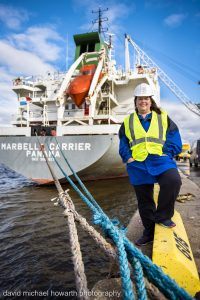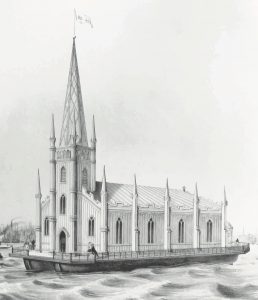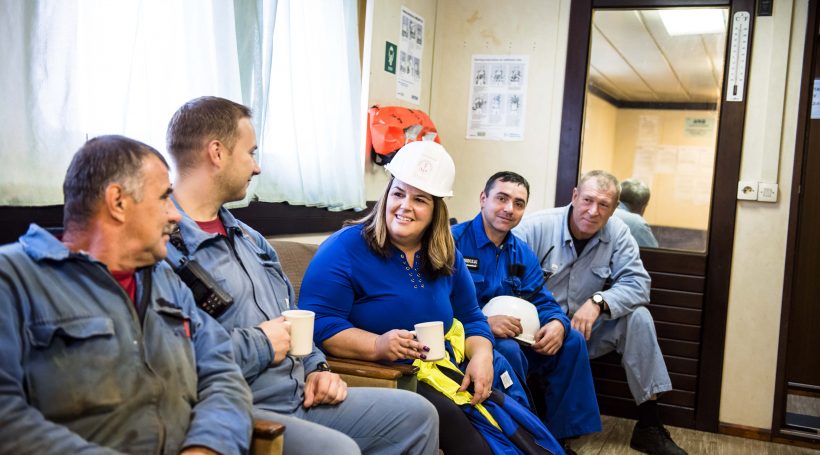 The port cities along the western edge of South Jersey owe their history, their industry and, in many cases, their very existence to one thing: the river.
The port cities along the western edge of South Jersey owe their history, their industry and, in many cases, their very existence to one thing: the river.
The deep, wide, navigable section of the Delaware River begins near Trenton and flows south to the Atlantic Ocean, creating a passage that ships loaded with steel, oil, produce – and, well, everything else – have used for hundreds of years to reach cities and towns along its shores.
Ships still arrive in South Jersey’s ports by the thousands every year, manned by crews of mostly young men whose needs, when they arrive at the docks, range from the personal and the medical to the spiritual. That’s where the Seamen’s Church Institute of Philadelphia and South Jersey (SCI) comes in.
“We’re a hidden mission,” says Helene Pierson, SCI’s executive director. When most people buy pineapples in the grocery store or fill their cars with gas, they’re not thinking about the crew of the ship that brought those goods to South Jersey. “Because of port security, most people never even see the seafarers, but in this region alone we have 35,000 of them coming up the Delaware every year. Nobody thinks about them, and very few people even know about them.”
Pierson leads a small group of volunteers, including three chaplains, who board almost every boat that comes into the ports of South Jersey and Philadelphia to tend to the needs of the crew aboard. Sometimes that’s as simple as bringing along a WiFi hotspot so they can Skype with their families or giving them a lift to Walmart to stock up on toiletries. Other times, it means providing access to medical care, helping them resolve pay disputes or holding religious services.
One of their biggest annual initiatives involves putting together “ditty bags” – care packages with toiletries, work gloves and winter hats. “Sometimes it’s winter but they’re sailing from somewhere warm, so the seafarers don’t come with coats or hats,” Pierson says.
“It’s our mission to take care of those who take care of us,” she continues. “It’s still a huge profession, and they have to leave their families sometimes for months and months at a time. They’re out there serving us every day.”
Pierson references a 2013 book by Rose George called “Ninety Percent of Everything.” Despite the assumption most people make – that fewer goods today are transported by sea – it’s actually a growing industry. “Trade carried by sea has grown fourfold since 1970 and is still growing,” George writes. “In 2011, the 360 commercial ports of the United States took in international goods worth $1.73 trillion, or eighty times the value of all U.S. trade in 1960.”
Today, SCI is headquartered in the naval yard on the Philadelphia side of the river, but it used to be a bit more conspicuous. Founded in 1843, its first home was actually on the river, inside the Floating Church of the Redeemer.

The Floating Church of the Redeemer in 1843
Builders lashed together two used 100-ton barges and constructed a wooden, Gothic-style church, complete with a 75-foot steeple, a pipe organ and huge painted frescos. The church was pushed and pulled along the river by tugboats, visiting the ships in port.
There were problems, predictably, with a floating cathedral. When the waves on the Delaware got choppy, it was difficult to stay on your feet inside. It had a tendency to tip in high winds and, once, it even sank and had to be salvaged from the bottom of the river. In 1853, the church was towed to Camden, drydocked at Broadway and Royden Street, and renamed St. John’s Episcopal Church. A fire destroyed the original wooden structure sometime around 1870, and it was rebuilt out of stone. Today, it is known as St. Augustine’s.
The modern SCI, Pierson says, caters mainly to young men from the Philippines, who make up more than a third of all crews worldwide. According to George, a quarter of a million Filipinos are at sea at any given time.
“Our job is to welcome them, to communicate with them and to help them communicate,” Pierson says. “Years ago we’d bring rolls of quarters for the pay phone banks at the South Jersey ports. Today we bring WiFi. Less than 10 percent of ships have access to the internet when they’re at sea. They can’t wait to talk to their families.”
Pierson says SCI is accustomed to dealing with all kinds of issues, ranging from professional problems to hospitalizations.
“There are still a lot of companies out there under all different kinds of international law, some of which are really lax on enforcement,” she says. “Sometimes we board a ship and head to the mess hall, and the seafarers are lined up to talk to us because they haven’t been paid in a month. They’re working so they can send money back home, and that’s a big deal. We partner with a union most ships are covered by, and we work with them to get the seafarers paid.”
Pierson says SCI volunteers and chaplains often have to make sure seafarers with medical issues get safely off the ship and in to see a doctor. “We see a lot of appendicitis,” Pierson says. “A lot of these seafarers are in their early 20s or younger, which is the prime time for appendicitis to hit. Our Lady of Lourdes Medical Center in Camden is usually the go-to. Especially when they’re sick and they have no family here, we let them know we’re somebody they can trust.”
In addition to leading regular all-denomination religious services aboard vessels, SCI’s chaplains get called in on the rare occasion that a ship pulls into port with a deceased seafarer aboard.
“It does happen, every once in a while,” Pierson says. “We send in our chaplains to provide ministry and help make any necessary funeral arrangements.”
The organization offers all their services to seafarers for free. SCI’s funding comes from trusts set up in the early 20th century, plus fundraising events and private donations. And despite the fact that a lot of people don’t know they exist, Pierson says SCI will keep its doors open as long as there are ships coming up the Delaware.
“We try to get to every single ship that pulls into port,” she says. “There are 30 terminals on either shore of the river – 12 of them in South Jersey from Burlington to Paulsboro – and it comes out to be about 1,700 ships a year we’re visiting. We work seven days a week, morning and night. It’s important to us that these seafarers who are arriving in the country as strangers are greeted with a friendly face and an offer of help for whatever their needs might be.”














